Sep
29
2010
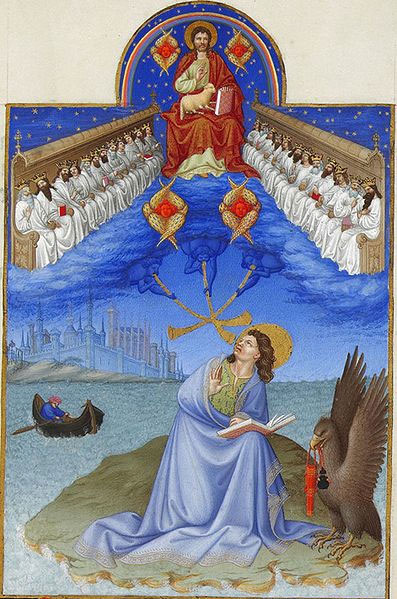
“What was from the beginning, what we have heard, what we have seen with our eyes, what we have gazed upon and our hands handled concerning the word of life—and the life was manifested, and we have seen and bear witness and announce to you the life, the eternal one, which was toward the Father and was manifested to us—what we have seen and heard, we announce also to you…”
IF I BELIEVE that the first resurrection occurred around AD70 [1], and that the New Covenant administration consists of saints living and reigning with Christ in heaven [2], these “joint-heirs” become co-mediators in some fashion. Does this open the door to the Roman Catholic practice of praying to glorified saints, or to the Eastern Orthodox love for beautiful icons?
Continue reading
8 comments | tags: AD70, Holy Place, John, Millennium, Peter Leithart, Revelation 20, Roman Catholicism | posted in Against Hyperpreterism, Biblical Theology, Quotes, The Last Days
Aug
28
2010
or Preterism is not a Dirty Word
 .
.
One thing that has struck me since becoming a preterist is how much evangelicals play down the badness of the baddies in the New Testament, i.e. the unbelieving Jews and Christian Judaisers.
Evangelicals would never believe that Jesus and the apostles were mistaken in their warnings of an imminent judgment (and let’s face it, this imminence is a facet of the New Testament that is inescapable). So the only other option they see as viable is a position that defies logic: an event that was near, at the doors, yet could happen at any time over next few millennia.
Continue reading
4 comments | tags: antichrist, Evangelicalism, Hermeneutics, John, Peter Leithart, Preterism | posted in Biblical Theology, The Last Days
Aug
14
2010

“Do you suppose that I came to give peace on earth? I tell you, not at all, but rather division.” Luke 12:51
Another weird idea James Jordan presents in his Revelation lectures is the premise that the famous Four Horsemen of the Apocalypse represent the gospel. As Uri Brito wrote a couple of years ago, first you think Jordan is nuts; then, as you continue to study, you think he is less nuts. Finally you give in and accept his genius, because his premise is vindicated by the similar use of the symbols in the Old Testament, and the literary structure of the event.
Continue reading
Comments Off | tags: AD70, Balaam, Herod, John, Literary Structure, Numbers, Revelation, Systematic typology, Zechariah | posted in Bible Matrix, Biblical Theology, The Last Days, The Restoration Era
Aug
11
2010
The Art of Interpretation

Oh, the depth of the riches and wisdom and knowledge of God! How unsearchable are his judgments and how inscrutable his ways! (Romans 11:33)
Hermeneutics is a big word you learn at Bible College. It is the study or practice of interpreting texts in the areas of literature, law and religion.
In literature, discovering the intent of an author can be an enlightening game. In law, one’s life (or life sentence) can hang in the balance of a judge’s interpretation. In religion, besides plumbing the depths of the mind of God, it is an enlightening game in the balance of which many lives hang. God has revealed His mind in His Word, and has also seen fit to give to His people the often difficult job of interpreting it.
[This post has been refined and included in Sweet Counsel: Essays to Brighten the Eyes.]
Continue reading
Comments Off | tags: Ezekiel, Hermeneutics, John, Literary Structure, Revelation, Timothy, Typology, Warren Gage | posted in Biblical Theology
Jun
1
2010

I said, “You are gods, and all of you are children of the Most High. But you shall die like men, and fall like one of the princes.” Psalm 82:6
As discussed elsewhere here, the five-point Covenant model as it gets played out in history becomes seven-point. The central “Ethics” gets split into three: Law-Testing-Law.
Moses, the Covenant head, ascends and receives the Law. He opens it for Israel as Mediator. Israel, as body, is tested under the Law. The Law is given again to a “resurrected” Israel, the next generation.
In microcosm, we see this in the incident with the golden calf. Moses is given the Tablets, Israel is tested, and the Tablets are broken. Moses brings the Law a second time.
In macrocosm, the Law is given from Sinai, Israel is tested for forty years, and Moses brings the Law again in Deuteronomy to a “resurrected” Israel, the next generation.
Continue reading
Comments Off | tags: Exodus, John, Moses, Pentecost, Peter Leithart, Vindication, Zechariah | posted in Against Hyperpreterism, Biblical Theology, Quotes, The Last Days
May
13
2010
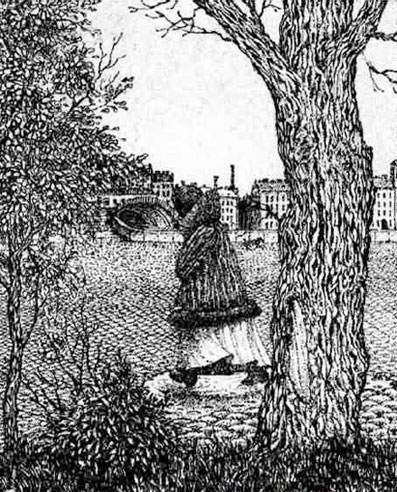
or Jesus, the Destroying Angel
James Jordan says the Revelation is like one of those old human anatomy teaching aids, the ones with layers of acetate. One starts with the skeleton and overlays the nervous system, arteries, organs, etc. They are all connected and yet each is a system that is individually identifiable. This is literature that is irreducibly complex.
Continue reading
1 comment | tags: AD70, Creation Week, James Jordan, Jericho, Jezebel, John, Lampstand, Literary Structure, Revelation, Totus Christus | posted in Biblical Theology
Mar
25
2010
or Jesus in the Synagogue of Satan
I am jealous for you with godly jealousy. For I have betrothed you to one husband, that I may present you as a chaste virgin to Christ. But I fear, lest somehow, as the serpent deceived Eve by his craftiness, so your minds may be corrupted from the simplicity that is in Christ. For if he who comes preaches another Jesus whom we have not preached, or if you receive a different spirit which you have not received, or a different gospel which you have not accepted — you may well put up with it! (2 Corinthians 11:2-4)
Read Fighting Over the Children and The Finger of God before you read this post.
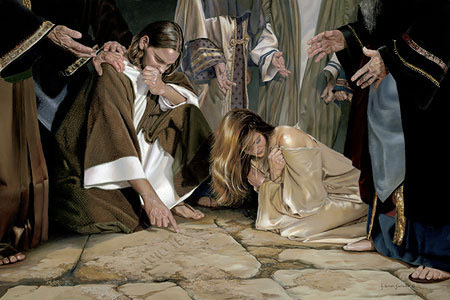
John’s account concerning the woman caught in adultery highlights the satanic nature of legalism. The garden of Eden is not replayed here; rather, it is a sequel.
You must be logged in to see the rest of this post.
Join now for a year for $15!
The woman stands in the midst (a phrase that occurs twice). She is the Altar of Incense, the fragrant “army.” The scribes and Pharisees are the false Lampstand, standing in for satan as his body. He is, after all, their father. They bring no male lover to be condemned. She has been enticed and now stands accused. Her sin is one of wandering astray. Their sin is high-handed.
Continue reading
Comments Off | tags: Feasts, Genesis, John, Lampstand, Satan, Worship | posted in Biblical Theology
Sep
18
2009
Excerpts from Peter Leithart’s new book, Deep Exegesis: The Mystery of Reading Scripture:
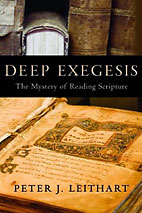 “My insight, if such it is, into the workings of humour was reinforced and generalised when I watched Shrek, a movie that I now tell my students is a gold mine of hermeneutical insight. All the funny parts of that film assume that the viewer has information the movie does not provide, information from three main sources: nursery rhymes, fairy tales, and popular culture, especially movies…”
“My insight, if such it is, into the workings of humour was reinforced and generalised when I watched Shrek, a movie that I now tell my students is a gold mine of hermeneutical insight. All the funny parts of that film assume that the viewer has information the movie does not provide, information from three main sources: nursery rhymes, fairy tales, and popular culture, especially movies…”
Johannine Jokes
…How does all this apply to our reading of Scripture? Scripture has the same literary properties as the texts we have been examining. Just as Eliot read Dante who read Virgil who read Homer, so Matthew had read Jeremiah, who knew Kings (or wrote it), and the writer of Kings had read the Hexateuch. Let us look at some examples. Let me tell some biblical jokes, again taken from John 9.
Continue reading
Comments Off | tags: Culture, Hermeneutics, John, Joke, Peter Leithart | posted in Biblical Theology, Quotes
Jul
19
2009
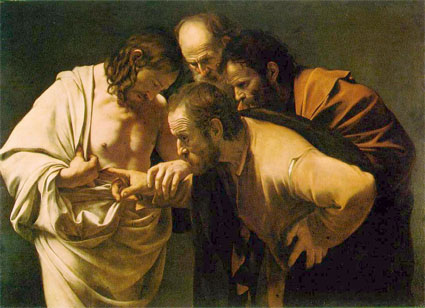
Sabbath - Then, the same day at evening, being the first day of the week,
…..Passover - when the doors were shut where the disciples were assembled,
…..for fear of the Jews,
Continue reading
Comments Off | tags: Feasts, John, Literary Structure, Passover, Systematic typology | posted in Biblical Theology
Apr
22
2009
“Then He said to the disciple, ‘Behold your mother!’ And from that hour that disciple took her to his own home.” John 19:27
Although they are spread throughout the four gospels, Jesus’ seven words from the cross are easy to put in chronological order. Once in order, they follow the themes of the annual Feasts.
At Firstfruits, Christ on the cross is Moses, mediating between heaven and earth. From the mountain, He transfers His legal responsibility for His mother to John.
He calls her Woman. At this point in the garden, the Lord married Adam to Eve. Of the seven elected Judges, this is Deborah, the warrior-mother. This step is always about the Covenant head lifted up to make a house for Greater Eve.
With this loving act, Christ prefigures the responsibility for the faithful remnant of Old Covenant Israel being transfered to the Apostles.
Interestingly, Revelation 18:7-8 follows the same structure. At the Firstfruits/’Woman/Bride’ step, Israel, who has rejected and killed her Messiah, says, “I am no widow.”
Comments Off | tags: Feasts, Firstfruits, Greater Eve, John, Mary, Moses | posted in Biblical Theology, The Last Days


































